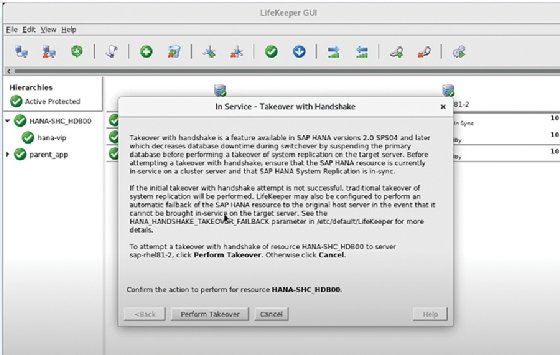
Getty Images/iStockphoto
SIOS Protection Suite update enhances HA for cloud and SAP
Improvements to the SIOS Protection Suite include planned failovers of SAP S/4HANA with zero downtime, GCP support and integration with third-party tools via CLI.
The latest updates to the SIOS Protection Suite for Windows and Linux make high availability clusters easier to manage and more reliable during failovers.
The SIOS Protection Suite consists of LifeKeeper and DataKeeper, which are, respectively, a failover clustering software and a block-level replication software. Combined, they enable high availability (HA) for customers' critical applications by monitoring the status of all application components and quickly failing them over to a secondary server if necessary.
The SIOS Protection Suite also includes Application Recovery Kits tailored for specific applications, such as Microsoft SQL Server, Oracle and SAP S/4HANA. These kits integrate with the applications to provide simplified setup and automation for recovery tasks.
This week's SIOS Protection Suite for Linux update to version 9.5.2 includes launching a load balancing tool for Google Cloud Platform to allow customers to manage high availability clusters running in GCP. The tool helps customers with IP management and other transferring functions during failovers and switchovers. SIOS already has this feature for Azure and AWS.
SIOS Protection Suite for Linux improved its SAP support in this update. The product can now support HANA's "Takeover with Handshake" option, which allows a secondary server to quickly take on the database transactions of the primary server. This eliminates the need to shut down the primary server before switchover, which would lead to downtime.
"This is a feature that's been requested by quite a few customers," said Ian Allton, solutions architect at SIOS Technology Corp. "It's good for planned maintenance, where you don't want to incur a disruption."

With this update, all SIOS Protection Suite for Linux functions are available via command-line interface (CLI), providing third-party automation tools such as Ansible a way to tell SIOS to execute its functions. Ninety-eight percent of customers use SIOS' native interface, but the remaining customers are large organizations that use standardized tools for monitoring their entire infrastructure, Allton said. Until now, there was no way to expose SIOS' functions to those other tools.
Exposing SIOS' functions via an API is on the roadmap, but that's still in development, according to Allton. CLI is a "good interim solution," he added.
On the Windows side, SIOS Protection Suite version 8.8 adds a new recovery kit for AWS Elastic Compute Cloud and Amazon Route 53. Unlike the other major public clouds, AWS has different subnets between regions, which creates extra complications when trying to configure automated failover across regions. This update issues commands to change routing tables during failovers, preserving a seamless transition. The Linux version of SIOS Protection Suite already has this feature.
The SIOS Protection Suite is generally licensed on a per-node basis, but customers can also license by individual Application Recovery Kit. It is most directly comparable to HA clustering software such as ClusterLabs' Pacemaker and Oracle RAC.
With more employees working from home and creating distributed and heterogeneous remote environments, IT uptime has become even more critical than before, said Krista Macomber, senior analyst at Evaluator Group. Automation plays a big role in maintaining that uptime, as failover for critical applications contains many moving parts, and it all must be executed quickly and correctly. There is definitely market demand for third-party software for HA and disaster recovery automation, Macomber said.
Although HA technology for critical applications is there, execution is still shaky, Macomber added. Application-driven availability tends to be handled in a very isolated manner, and vendors such as SIOS target the specific application user -- not the IT team that, ultimately, has to implement the technology.
"This tends to create issues between application owners and IT operations due to the need to coordinate between them for updates or other changes. This coordination is challenging and tends to break down over time," Macomber said.
However, DR orchestration and HA capabilities are starting to appear in core data protection offerings, Macomber said. Since these features are integrated into products IT administrators work more closely with, they hold greater appeal than a separate product tailored specifically to provide HA for one application.






